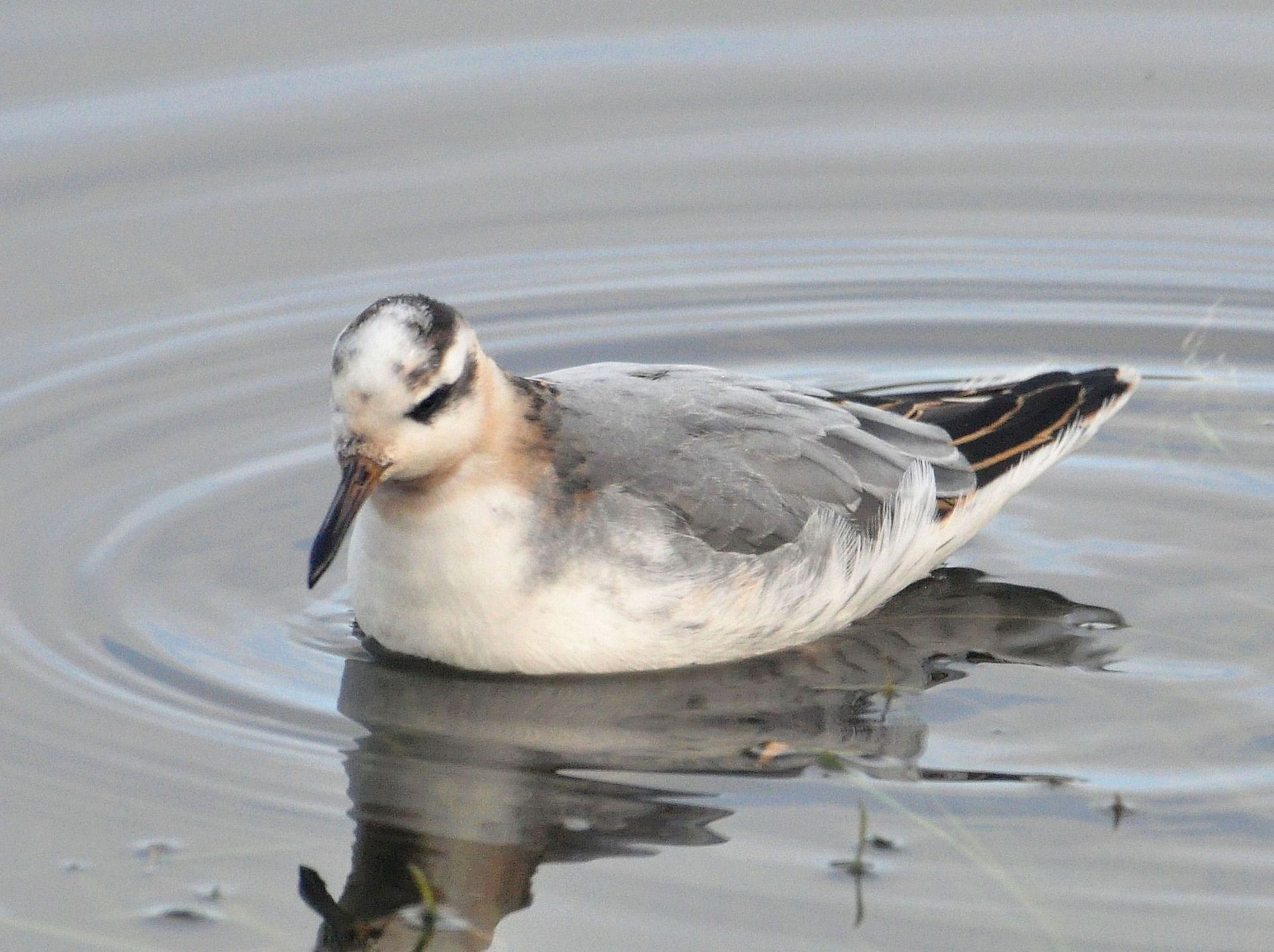- Home
- General Information
- Sightings
- Birding Locations
- Publications
-
Archive 1987 - 2018
- A Checklist of Bradford's Birds
- Swans & Geese
- Ducks & Sawbills
- Divers, Grebes, Herons
- Eagles, Kites & Harriers
- Buzzards & Hawks
- Falcons
- Grouse, Quail, Crakes
- Waders - Part1
- Waders - Part 2
- Skuas and Gulls
- Terns & Auks
- Doves, Nightjar & Alpine Swift
- Hoopoe, Wryneck, Larks, Pipits
- Owls, Woodpeckers
- Thrushes
- Warblers and Tits
- Shrikes and Crows
- Sparrows, Buntings and Finches
- Gallery
Waders - Part 2
JACK SNIPE Lymnocryptes minimus
Uncommon passage and winter visitor
Recorded each year from 1987 to 2013. Most recent sightings:
2014 -
As many as 15 birds were involved in the reports which came from the usual environs of Soil Hill, and Braithwaite Edge, above Keighley as well as Farnley Moor. The reports from the bleak summit of Soil Hill clearly concerned three birds, seen as singles during January, April and December. The Farnley Moor record was another winter bird on 30th January, but the sightings at Braithwaite Edge consisted of 11 reports of single birds, spread throughout the second winter period from the middle of October to the end of the year.
2015 -
Last year’s profusion of records was not repeated. This was due almost entirely to access being denied to a private patch of land at Braithwaite Edge, where wintering birds often gathered. There were also no sightings from Soil Hill. However, we did have two records: a bird was flushed from a soggy field at Apperley Bridge which also contained Common Snipe on 1st March and another was seen in similar circumstances at Otley Wetland on 31st January.
2016
- Whilst only five observers submitted reports from five sites, as many as 30 individual birds could have been seen. This bird is clearly a migrant in the area, rather than a winter resident, and the pattern of sightings at the regularly watched spots tends to indicate birds move on fairly quickly. As such, it is unlikely this figure is overstated, but, even allowing for some element of this, the number seen is comfortably a Group record. The sightings at the three main locations were;
Soil Hill: Singles on 18th March, and in autumn, 16th and 24th October, 4th, 5th, and 12th November.
Braithwaite Edge: Singles on 15th and 18th October, 5th and 27th November, and 4th and 17th December. Two birds were located on 14th October and 8th December.
Apperley Bridge: Singles on 20th October, 5th and 6th November, and 8th December. Two were present on 30th November, and 6th December, and an excellent four on 22nd October.
Elsewhere, a bird was flushed at Tong Park (Baildon) on 3rd November and there was an unexpected record of one passing Caldene Fields on the 17th.
2017
Good numbers were seen at two sites:
Keelham Bog: 11 between January and early March, and four in December.
Near Redcar Tarn: A single in February, one in March, three on a single day in November, and one in December.
In addition a dead bird was found on the road near Queensbury.
2018
- Access restrictions and a relatively dry second winter period possibly contributed to numbers being 50% down on 2017. Most reports came from Keelham Bog, where up to three were seen in January and February, and four in March. At Apperley Bridge, three birds were located, all in January.
BLACK-TAILED GODWIT Limosa limosa
Infrequent passage visitor
Recorded most years from 1987 to 2009. Most recent sightings:
2010
An excellent year produced five records. One was at Otley Wetland on 19th April, followed by three at Thornton Moor on 4th July, and three remarkably confiding birds at Redcar Tarn the day after. In August, two were at Thornton Moor on the 5th, and one on the 15th.
2011
Although there was only one record, it was a remarkable one. About 75 birds, in two simultaneous groups, flew east over Bolton Abbey on 19th March. This is comfortably a Group record, and a very high count for Yorkshire away from the Humber estuary.
2012
The flooded Silsden Ings proved popular for this species in 2012, and produced four records, commencing with two birds on 28th April, which had increased to 11 two days later. Presumed return passage had eight there on 24th June, and a single on 10th July. The April records coincided with a report of unseen calling birds flying over the valley near Pool on the 29th.
2014
Two birds flew from east to west over Oxenhope watchpoint on 27th September.
2016
- A passage bird at Low Moor on 20th June was a welcome local record, whilst another at John o’Gaunt’s between 15th and 23rd August was at a more expected location. This same period also produced a further individual at Thornton Moor on the 17th of the month.
2017
- The same bird was at Cononley Ings on 22nd and 23rd October, and a presumed different one on 26th November.
2018
- A reasonable six records produced singles at Cononley Ings on 6th March and 11th December, Pool on 25th February, and Park Dam on 14th September. Two were seen at Silsden Ings on 11th March, and three at Thornton Moor Reservoir on 3rd August.
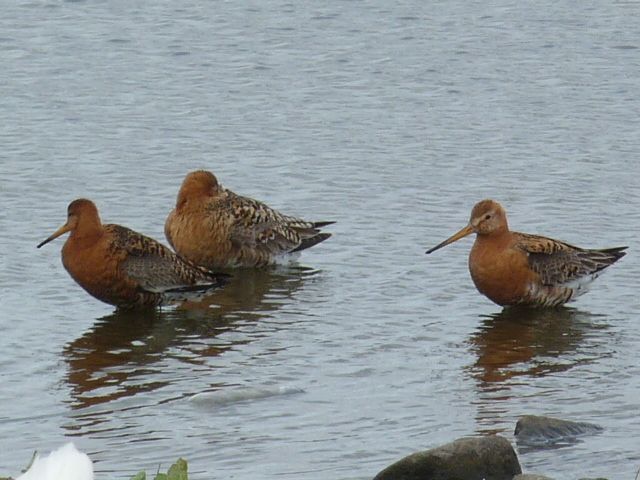
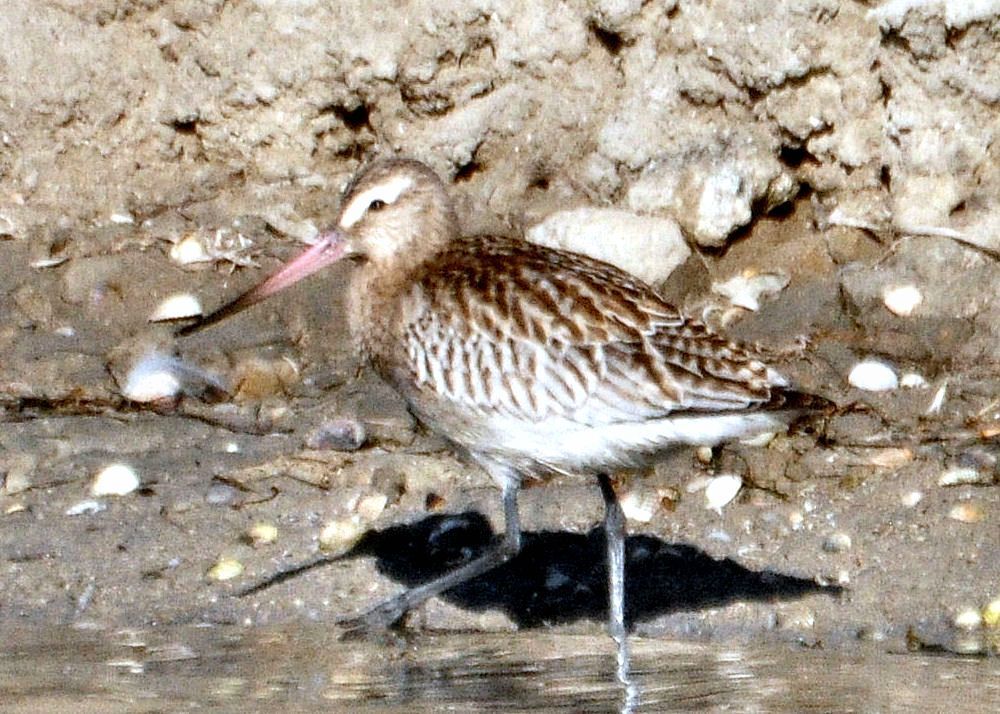
Bar-tailed Godwit at Thornton Moor Reservoir in 2010. photo: Brian Vickers
Black-tailed Godwits (left) at Redcar Tarn in 2012. photo: Keith Moir
BAR-TAILED GODWIT Limosa lapponica
Infrequent passage visitor
Recorded most years from 1988 to 2005. Most recent sightings:
2006
This year there were two more records than of the preceding species, although two of them are likely to refer to the same birds. Otley Wetland produced all but one of the reports. On 22nd January one flew over, but all the remaining records were in May. A good total of eight birds were present on the 1st, and what were almost certainly the same birds were seen at Bolton Abbey later in the day. The following day there were two birds, and this productive period concluded with another on the 7th.
2010
Nothing like as regular in the area as the preceding species, so four records is a good haul, though the first, a bird over Soil Hill on 25th April, may have been the one reported from Thornton Moor that day. The other records came from the second location: singles on 11th July and 7th August .
2011
Unusually, there were more records of this species than its congener. Singles, were seen at and near Thornton Moor Reservoir on 8th April, and in September on the 19th, 23rd and 24th. Different individuals were at Warley Moor on 2nd May, and three days later, and one was found at Kex Gill Quarry on the 6th.
2014
A single bird was seen at Thornton Moor Reservoir on 3rd October. This was the first record since 2011.
2015
Ten birds circled Warley Moor Reservoir (Fly Flatts) on 14th March, and then headed off towards the east. This was a record haul, surpassing the previous highest of eight birds at Otley Wetland in May 2006.
WHIMBREL Numenius phaeopus
Uncommon passage visitor
Recorded each year from 1987 to 2010. Most recent sightings:
2011 -
A rather poor return, with only four records. Five birds spent a short time at Otley Wetland on 22nd April, one overflew Oxenhope watchpoint on the 24th, and another was seen on the 28th at Warley Moor, which had the final sighting on 24th July.
2012 -
A fairly average year, with seven records, but rather better than some other recent years. All were unseen birds, calling as they passed, and the only spring report was one over Cononley Ings on 15th May. Return passage birds were reported in July from Warley Moor on the 5th, and Oxenhope watchpoint on the 21st, followed by August records there on the 11th and 12th, with a single past Barden Scale on the 11th, and two birds over Pool three days later.
2014 -
This was another poor year with just one record. On the 9th July, a bird at Leeshaw Reservoir flew off to the east with Curlews.
2015 -
There were three records all in the south of the area. The call of a flying bird alerted the observer as it flew over Keighley Moor Reservoir on 20th April and the second passed Warley Moor Reservoir on 17th May. The third visitor was photographed as it took off from the second location on 12th July.
2016
- This year was rather better than other recent ones, with 11 birds from nine records, and fewer than usual based on the familiar calls of overflying birds. Two birds went over Warley Moor Reservoir on 11th April, and one passed through Trough Lane (Denholme) on the 13th. The other spring records comprised a bird at Thornton Moor on 16th and 17th May, and one at Leeshaw on the 29th. Both these sites provided return passage records, with an individual at Thornton Moor on 10th July, and two there on 28th August, plus further singles at Leeshaw on 14th and 15th July. The picture was completed by a bird over the Washburn Valley, not a regular location, on 26th July.
2017
- A bird flew past Ogden Reservoir on 11th April, and another was at Leeshaw between 11th and 15th May.
2018
- A fairly average year, with single fly-overs at Silsden on 19th May and Otley Wetland on 1st August, and four over Farnley on 26th July.
SPOTTED REDSHANK Tringa erythropus
Scarce passage visitor
1988
A bird was seen and heard in flight over Rombald’s Moor on 13th May.
1990
A moulting adult was at Thornton Moor Reservoir on 10th August but only briefly.
2009
A relatively early passage bird flew over Thornton Moor Reservoir on 27th June
2011
A bird in breeding plumage at Silsden Reservoir on 28th April provided a nice contrast with the accompanying Common Redshank.
GREENSHANK
Tringa nebularia
Passage visitor
Recorded each year from 1987 to 2012. Most recent sightings:
2013
Just four records, all of them over a ten day period at the end of August. On the 21st, there was a bird recorded at Fewston Reservoir. Three days later, in the south of the area, four birds flew over Thornton Moor Reservoir, but two more came down to feed on the shoreline. On the 29th another bird was sighted at Ogden Reservoir and on the last day of the month a single dropped in to Leeshaw Reservoir.
2014
Once more, as last year, there were only four records. A bird was at Thornton Moor Reservoir on 20th and 21st July and another was present on 13th September. At Keighley Moor Reservoir a bird was seen on 3rd August and a second bird, present on the 18th August, was probably the same bird that was there four days later.
2015
Just three records, all of them in August, were very much in line with the two previous years. On the 9th a bird was seen at Lindley Wood Reservoir and on the 24th one arrived at Keighley Moor Reservoir in the early evening before flying off south-east. The final record was at Fewston Reservoir on 28th August.
2016
- Seventeen records and about eleven birds is a welcome upturn on recent dire years, but numbers are still well down on those which could be routinely expected in the 1990’s. In spring, two were at Ogden Reservoir on 11th and 12th May, and autumn passage produced a run of records at John o’Gaunt’s and Lindley Wood Reservoirs. At the first location, up to two birds were present between 21st and 29th August, and at the latter, individuals were recorded on the 25th, and on 2nd, 11th and 12th September. Thornton Moor Reservoir also produced birds: two on 1st September, and a different bird carrying blue and white Darvic rings the day after.
2017
- A single record of a bird at Keighley Moor Reservoir on 2nd September confirms the species’ increasing scarcity in the area.
2018
- After several dismal years, a return to form for Greenshank as well, though the 18 records may well involve fewer birds, as some perhaps remained for several days. The main sites were Warley Moor and Lindley Wood Reservoirs. At the first, singles were seen in August between 3rd and 5th, two were there on 14th and 15th, and there was one on 6th September. At Lindley Wood, there was a bird between 16th and 19th August, increasing to two on 22nd and 23rd, and another on the 30th. Elsewhere, singles were at Silsden Ings between 10th and 13th April, Keighley Moor Reservoir from 20th to 24th July, Thornton Moor on 26th, and Scargill on 12th and 13th August.
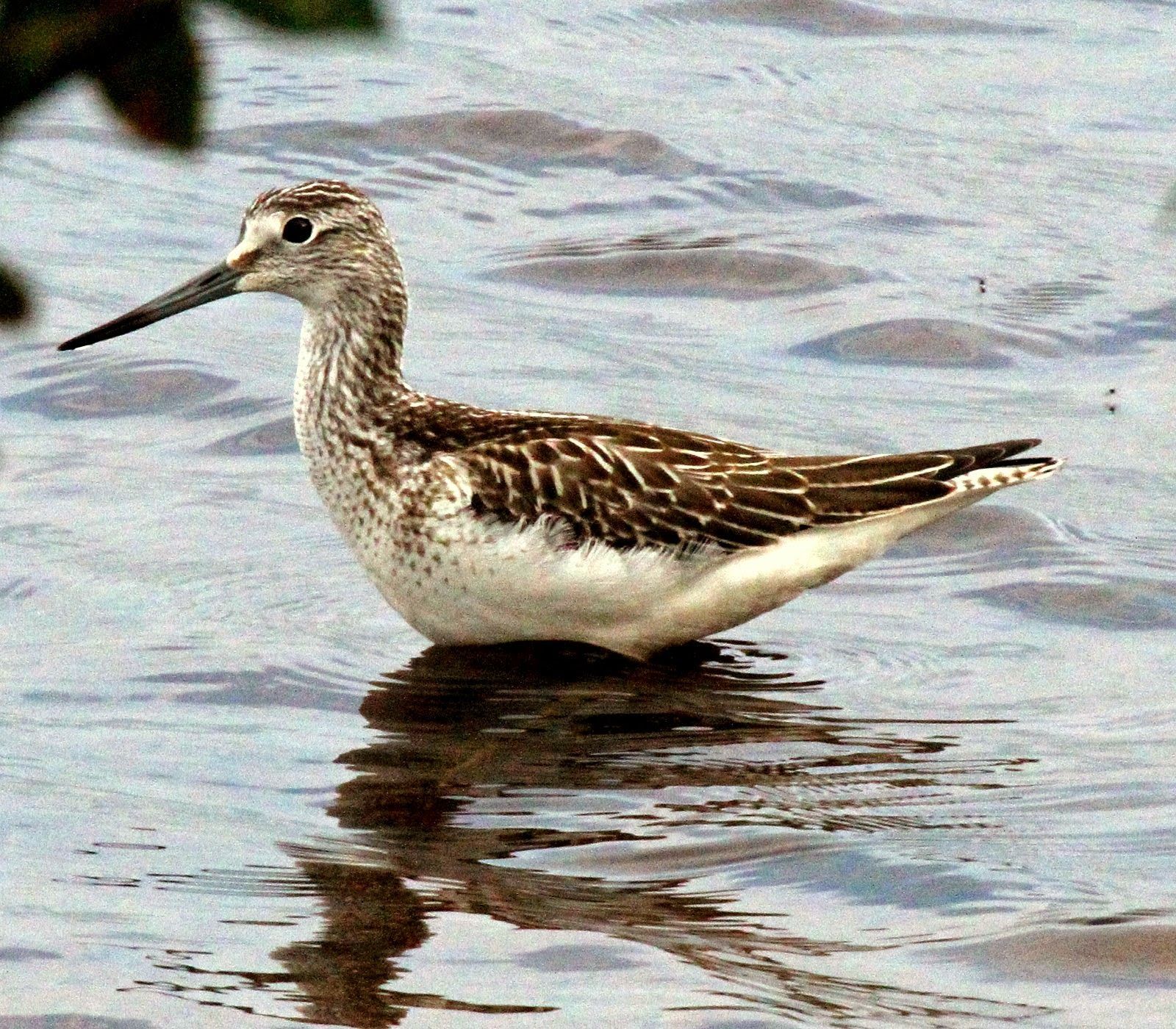
Greenshank at Thornton Moor Reservoir in July 2014. photo: Brian Sumner
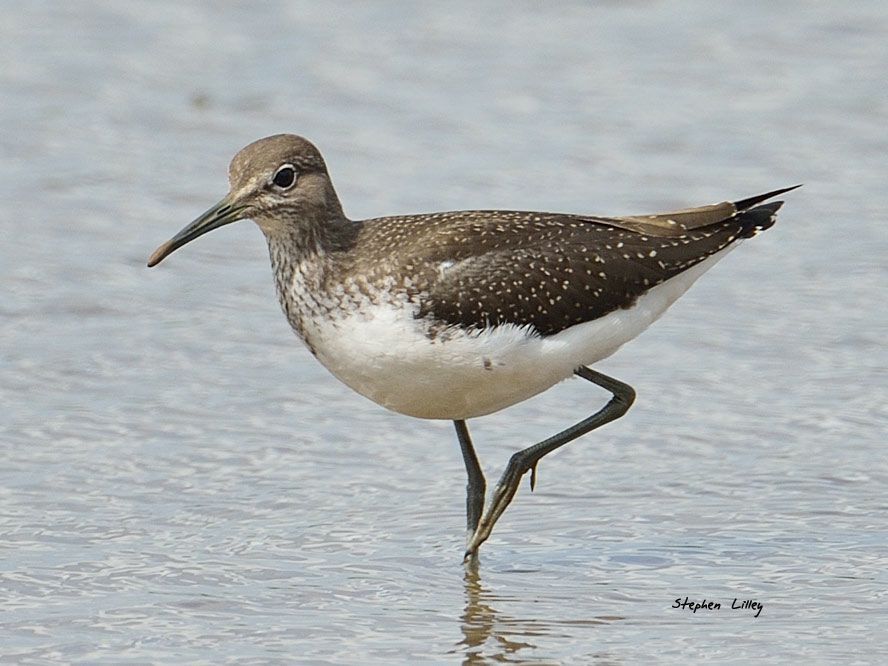
A Green Sandpiper at Beaverdyke Reservoir on 21st August 2012. photo: Stephen Lilley.
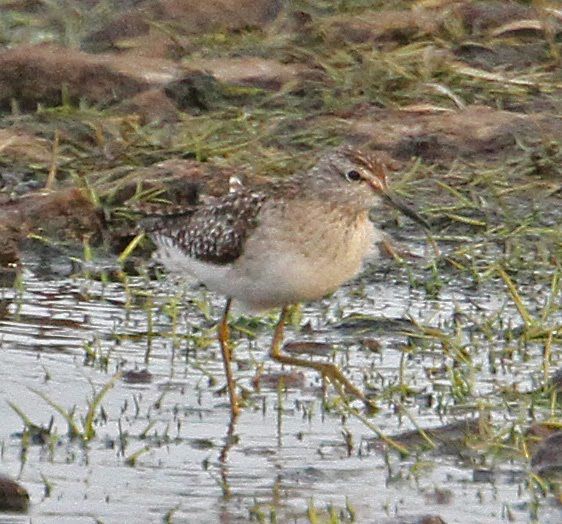
Wood Sandpiper at Thornton Moor Reservoir in May 2011. photo: Brian Vickers.
GREEN SANDPIPER Tringa ochropus
Passage visitor
Recorded each year from 1987 to 2012. Most recent sightings:
2013
A fairly average year, with nine birds recorded at six locations. There were no spring sightings, all but one of the recordings came from a three week period in August when birds were returning from their breeding areas to the north. On the 2nd of August a bird touched down at Stockbridge, stayed for a few brief moments until it was moved along by a Moorhen. There then followed reports of singles on the reservoirs at Warley Moor, Thornton Moor, Lindley Wood and John O’Gaunt’s before two birds were seen on Keighley Reservoir on the 22nd. The final bird was another single at Lindley Wood Reservoir on 24th September.
2014
With just four records, it was a disappointing year. Leeshaw Reservoir was visited by two birds, one on the 8th and the other on the 21st July. On 15th October, one was seen at Lindley Wood Reservoir and ten days later a bird dropped into Toad Holes Beck from the south-east before departing northwards.
2015
The numbers of these birds have dwindled considerably, and this year’s reports showed no change to this downward trend. Allowing for overlapping of sightings, there were seven records, the first of which was a bird seen at dusk on 13th June from the Oxenhope Watchpoint. On 22nd July there was another sighting at nearby Warley Moor Reservoir and on the last day of that month a bird stayed for a further three days at Keighley Moor Reservoir. During August a bird flew up from the river bed at Norwood Bottom on the 7th and in the middle of the month one was seen in Denholme Clough. There was a record from Otley Wetland on 24th August and the final report was the sighting of two birds on the river at Burley-in-Wharfedale on 28th October.
2016
- Even by recent standards, a very poor year, with just two records. A bird at Keighley Moor Reservoir from 1st to 4th August, was followed by another at Lindley Wood six days later.
2017
- Three records: in July singles were at Otley Wetland on the 20th (JM), and John o’ Gaunt’s Reservoir on the 25th, and one was seen at Sugden End Reservoir on 4th August.
2018
- A much improved picture saw 10 records of probably eight birds, all on autumn passage. In August, there were singles at the reservoir sites of Keighley Moor on 1st and 3rd, Ogden on 4th, Scargill on 28th, and Lindley Wood on 30th, and two were at Warley Moor on the 4th. The remaining sightings in September came from John o’ Gaunt’s Reservoir on 22nd and 23rd, and Oxenhope Watchpoint on 24th.
WOOD SANDPIPER Tringa glareola
Rare passage visitor
1994
A single adult summer plumaged bird skulking in a pool on the south-west shore of Thornton Moor Reservoir was flushed by police dogs during the mid-afternoon of 12th May. Fortunately this bird remained at the site feeding on the shore until late evening.
1996
Calls from a flying bird were heard above Beaverdyke Reservoir on 9th September. A further bird at Chelker Reservoir on 24th September was a very confiding individual, which was observed feeding on the south bank until it was flushed by a fisherman, upon which it flew off high to the south-west.
2011
On a happier note, this species was recorded for the first time in 15 years, and for only the fourth time in all. The well-watched individual was at Thornton Moor Reservoir on 6th May.
SPOTTED SANDPIPER Actitis macularia
Vagrant
1990
A superb summer-plumaged adult was found at Elland Gravel Pits on 31st May and was last reported on 2nd July. The bird was thought to be a female and was even observed copulating with a Common Sandpiper which kept it close company during most of its stay.
TURNSTONE Arenaria interpres
Infrequent passage visitor
Recorded most years from 1987 to 2003. Most recent sightings:
2004 Three arrived at Thornton Moor in the late afternoon of 8th August.
2005 Birds were seen at Thornton Moor Reservoir in both passage periods. One was seen on 2nd May, and four on 10th September.
2006 A reasonable year started with a bird, presumably the same one, at Otley Wetland on 7th and 8th May, and a good total of four birds at Warley Moor Reservoir three weeks later . As in 2005, autumn passage also produced a bird, seen at Thornton Moor Reservoir on 1st August.
2008 There were two May records: a single at Thornton Moor Reservoir on the 5th, and two at Warley Moor Reservoir on the 30th.
2010 Thornton Moor is the usual site for this species, and one was found there on 5th September.
2011
Three birds flew north at Warley Moor Reservoir on 7th May.
2013
Two birds were present at Thornton Moor Reservoir on 21st July and there were two more records: a single here on 16th September and two at the nearby Warley Moor Reservoir on the previous day.
2016
- Four birds is a reasonable tally for a less than annual species, and all were seen at Thornton Moor Reservoir. A single on 19th May, was followed by three on 19th August.
2018
- Another excellent Warley Moor record of one on 26th July, with another found Scargill Reservoir on 7th August.
WILSON'S PHALAROPE Phalaropus tricolor
Vagrant
1997
Two fortunate observers were at the Thornton Moor Reservoir watchpoint during the midday period on 20th September, when a bird considered to be of this species was observed wading and swimming before departing to the south-west at 1400 hours. Note: A small-scale influx of this vagrant American species occurred nationally around the time of this sighting.
GREY PHALAROPE Phalaropus fulcarius
Vagrant
2002
This species, not recorded before in our area, provided excellent, close views at Fewston Reservoir on 3rd November. A juvenile, moulting into first winter plumage, it stayed close to the bank during the first day, was rather more elusive for the next two days, and was last seen on 6th November.
2010
One found at Bradley Ings on 18th November was seen only briefly and distantly there, but it was then relocated at Cononley, where it provided excellent views until its departure on the 21st. Not seen since 2002, and only the second Group record.
The Grey Phalarope at Bradley Ings, November 2010.
Photo: Brian Vickers
RED-NECKED PHALAROPE Phalaropus lobatus
Vagrant
1999
The discovery of a first-summer male Red-necked Phalarope at Thornton Moor Reservoir on 22nd May was an event of wide-reaching importance. The bird stayed for just over two days, and by the time of its departure (around 9.30pm on 24th May) around 100 birders from all over the country had enjoyed splendid views of this all-too-rare visitor to the Group’s recording area
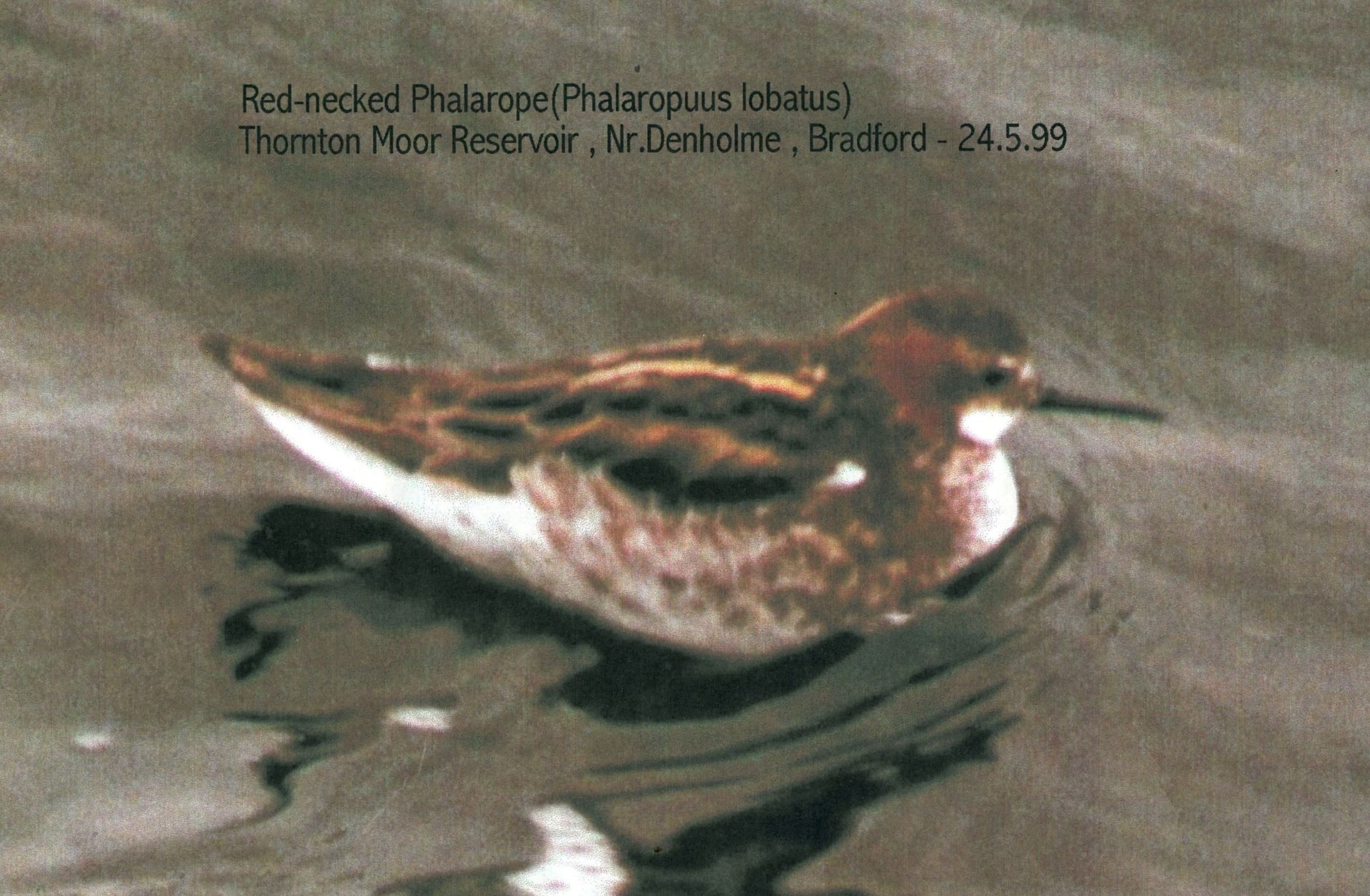
Red-necked Phalarope at Thornton Moor Reservoir on 24th May 1999.
